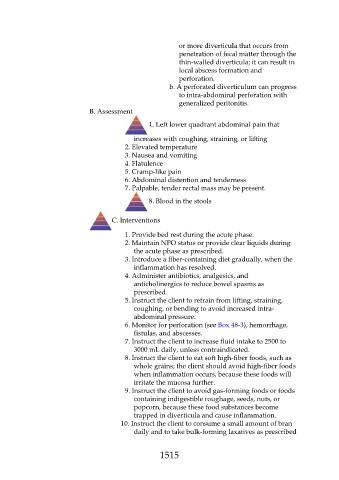Page 1515 - Saunders Comprehensive Review For NCLEX-RN
P. 1515
or more diverticula that occurs from
penetration of fecal matter through the
thin-walled diverticula; it can result in
local abscess formation and
perforation.
b. A perforated diverticulum can progress
to intra-abdominal perforation with
generalized peritonitis.
B. Assessment
1. Left lower quadrant abdominal pain that
increases with coughing, straining, or lifting
2. Elevated temperature
3. Nausea and vomiting
4. Flatulence
5. Cramp-like pain
6. Abdominal distention and tenderness
7. Palpable, tender rectal mass may be present.
8. Blood in the stools
C. Interventions
1. Provide bed rest during the acute phase.
2. Maintain NPO status or provide clear liquids during
the acute phase as prescribed.
3. Introduce a fiber-containing diet gradually, when the
inflammation has resolved.
4. Administer antibiotics, analgesics, and
anticholinergics to reduce bowel spasms as
prescribed.
5. Instruct the client to refrain from lifting, straining,
coughing, or bending to avoid increased intra-
abdominal pressure.
6. Monitor for perforation (see Box 48-3), hemorrhage,
fistulas, and abscesses.
7. Instruct the client to increase fluid intake to 2500 to
3000 mL daily, unless contraindicated.
8. Instruct the client to eat soft high-fiber foods, such as
whole grains; the client should avoid high-fiber foods
when inflammation occurs, because these foods will
irritate the mucosa further.
9. Instruct the client to avoid gas-forming foods or foods
containing indigestible roughage, seeds, nuts, or
popcorn, because these food substances become
trapped in diverticula and cause inflammation.
10. Instruct the client to consume a small amount of bran
daily and to take bulk-forming laxatives as prescribed
1515

